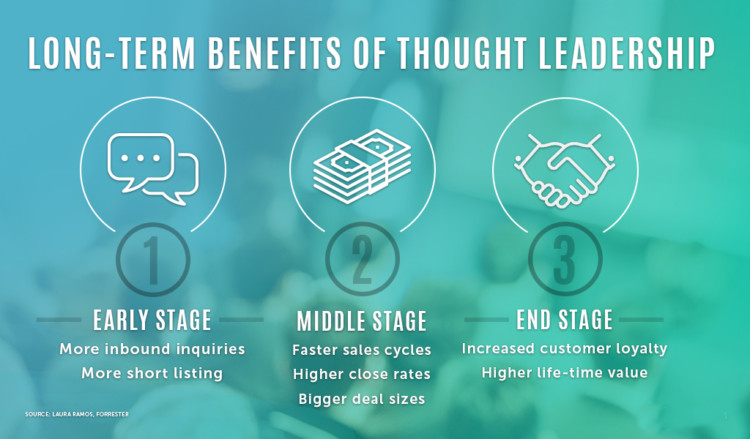
Thought leadership is a marketing technique to differentiate you, an organization or brand from competitors by attracting attention and creating a positive, durable affinity.
Thought leadership demonstrates expertise by expressing insightful ideas in a compelling, audience-pleasing way. Blogs, op-eds, videos, podcasts, speeches, whitepapers and interviews are typical thought leadership vehicles. However, actions and stands on contentious issues can be more visible and influential forms of thought leadership expression.
While the value of thought leadership is often equated with external influence, it also can be a useful internal process to discover a team’s unrecognized expertise or an unexploited brand feature. Thought leadership requires introspection and discipline to understand your true expertise as well as how and where to express it effectively.
Thought leadership is a form of strategic thinking. Thought leaders look at the big picture to discover emerging trends, looming dangers or unrecognized realities. They study how their organizations stack up against competitors. They read to find insights they can apply. They search for white spaces in public forums where they can attract attention, inform and influence through thought leadership.
Thought leaders gain the most influence by practicing what they preach. Pontificating without substance can attract negative attention and forfeit influence. Putting actions behind words builds trust by showing you believe in what you say.
Many people shy away from thought leadership because they doubt their own or their team’s unique expertise. To be heard, you don’t need to be unique. You need to express a clear point of view, answer big questions clearly and back up your insights with facts or data. Your thought leadership expertise may be seeing and applying the insights of others, much as innovators apply someone else’s inventions.

Jargon is a major turn-off in thought leadership and limits the reach of your insight to the handful of people who know what your jargon means. Using jargon connotes smugness, not thoughtfulness.
While thought leadership can be a powerful tool, it takes more than posting content to earn influence. You need to know the audience you seek to influence. You need a good hook. And, you need to push your thought leadership through relevant and multiple channels that connect with those you want to influence.
Piggybacking on trending news can be a way to supercharge thought leadership content. Be careful not to comment just to comment. But if you have something valuable to add to a breaking event, it’s a good train to ride.
Consistently posting thought leadership content is necessary to win and influence an audience. A one-and-done strategy usually doesn’t pan out. Thought leadership blogs, presentations and whitepapers often have an extended shelf life, which can be included in a portfolio or even a book to leverage original solid thinking. A steady stream of thought leadership posts reinforces a perception of subject matter mastery and as thought leaders.
Thought leadership is about marketing, but not hype. Self-promotion smells too much like advertising instead of information. Effective thought leadership should give off an aura of authenticity and originality. You should speak in your own voice. It’s less about selling and more about sharing. And, sharing can include insights you borrow from customers and clients about your products or services.
Thought leaders are sought out for their expert knowledge. Being in the spotlight sometimes means becoming a target. Few people like being targets, but thought leaders recognize the opportunity to restate their insight to a wider audience and demonstrate the leadership quality of grace under pressure.
Thought leadership is about marketing, but not hype. Effective thought leadership should give off an aura of authenticty and originality.
Pushback can be a source of thought leadership evolution. A good debate can reveal potholes in arguments or blindspots in reasoning. The give-and-take can burnish the reputation of a thought leader.
You don’t have to be the CEO of a major corporation to be a thought leader. Thought leaders can be anyone with insight and ideas that impact audiences ranging from school boards to entire communities, from customers to critics. Age, gender and ethnicity aren’t barriers, but can be foundations for fresh approaches to intractable problems.
Thought leadership comes more naturally to some than others. Don’t let that deter you from getting on a soapbox to proclaim your bright idea or insight. Anyone can be a thought leader, and the more the merrier.




